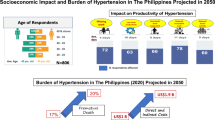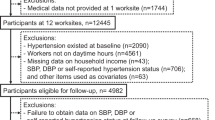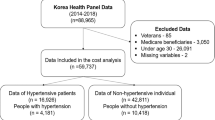Abstract
In the present study, we aimed to estimate the impact of hypertension in the working-age Japanese population. We developed life table models to estimate total deaths, years of life lived, and productivity-adjusted life years lived (a newly developed metric for quantifying the burden of acute and chronic health conditions on work productivity) among Japanese individuals with hypertension aged 20–64 years, with simulated follow-up until age 65 years. Data inputs were drawn from local population statistics and published sources. Gross domestic product per person employed, a measure of labor productivity, was used to assign an economic value to each productivity-adjusted life year lived. Outcomes and costs were discounted by 2% annually. In 2017, 26.3 million Japanese individuals aged 20–64 years (37.5%) had hypertension. Of these people, 23.7% were treated and had controlled blood pressure, 23.2% were treated but had uncontrolled blood pressure, and 53.1% were untreated. During the simulated follow-up until age 65 years, 335,342 deaths (28.0% of total deaths), 1.6 million years of life (0.8% of total), 3.1 million productivity-adjusted life years (1.9% of total), and US$242.9 billion or 28.3 trillion Japanese yen of gross domestic product were lost to hypertension. Our findings highlight the considerable economic burden of hypertension in Japan, as well as the importance of effective strategies for hypertension prevention and management, which are likely to deliver a significant return on investment.
This is a preview of subscription content, access via your institution
Access options
Subscribe to this journal
Receive 12 print issues and online access
$259.00 per year
only $21.58 per issue
Buy this article
- Purchase on Springer Link
- Instant access to full article PDF
Prices may be subject to local taxes which are calculated during checkout


Similar content being viewed by others
References
Mills KT, Stefanescu A, He J. The global epidemiology of hypertension. Nat Rev Nephrol. 2020;16:223–237. https://doi.org/10.1038/s41581-019-0244-2. 2020/04/01
Umemura S, Arima H, Arima S, Asayama K, Dohi Y, Hirooka Y, et al. The Japanese society of hypertension guidelines for the management of hypertension (JSH 2019). Hypertens Res. 2019;42:1235–481. https://doi.org/10.1038/s41440-019-0284-9. 2019/09/01
World Health Organization. Hypertension. Internet. 2020. Updated 13 September 2019. Accessed 5 August, 2020. https://www.who.int/news-room/fact-sheets/detail/hypertension
Japan, Ministry of Health, Labour and Welfare. The results of the National Health and Nutrition Survey 2017 (in Japanese). Internet. 2020. Accessed 17 August, 2020. https://www.mhlw.go.jp/stf/houdou/0000142359.html
Sakamoto H, Rahman M, Nomura S, Okamoto E, Koike S, Yasunaga H, et al. Japan Health System Review. 8. 2018. https://apps.who.int/iris/bitstream/handle/10665/259941/9789290226260-eng.pdf;jsessionid=47F729C7DDD4A8AD7463CC8F0ABEE3FC?sequence=1
Hisamatsu T, Segawa H, Kadota A, Ohkubo T, Arima H, Miura K. Epidemiology of hypertension in Japan: beyond the new 2019 Japanese guidelines. Hypertens Res. 2020. https://doi.org/10.1038/s41440-020-0508-z
Hirawa N, Umemura S, Ito S. Viewpoint on guidelines for treatment of hypertension in Japan. Circ Res. 2019;124:981–3. https://doi.org/10.1161/CIRCRESAHA.119.314991
The Japanese Society of Hypertension. The Japanese society of hypertension guidelines for the management of hypertension (JSH 2014). Hypertens Res. 2014;37:253. https://doi.org/10.1038/hr.2014.20. 2014/04/01
Virani SS, Alonso A, Benjamin EJ, Bittencourt MS, Callaway CW, Carson AP, et al. Heart disease and stroke statistics − 2020 update: a report from the American Heart Association. Circulation. 2020;141:e139–e596. https://doi.org/10.1161/CIR.0000000000000757
Japan, Ministry of Health Labour and Welfare. Summary of the medical health expenditure in 2017 (in Japanese). 2017. https://www.mhlw.go.jp/toukei/saikin/hw/k-iryohi/17/index.html
The Internal Revenue Service. Yearly average currency exchange rates. The United States government. 2020. Updated 10 January 2020. Accessed August 4, 2020. https://www.irs.gov/individuals/international-taxpayers/yearly-average-currency-exchange-rates
Hird RT, Zomer E, Owen JA, Magliano JD, Liew D, Ademi Z. Productivity burden of hypertension in Australia: a life table modeling study. Hypertension. 2019;73:777–84. https://doi.org/10.1161/HYPERTENSIONAHA.118.12606
Ademi Z, Ackerman IN, Zomer E, Liew D. Productivity-Adjusted Life-Years: A New Metric for Quantifying Disease Burden. PharmacoEconomics. 2021;39:271–3.
Magliano DJ, Martin VJ, Owen AJ, Zomer E, Liew D. The productivity burden of diabetes at a population level. (Report). Diabetes Care. 2018;41:979. https://doi.org/10.2337/dc17-2138
Hird TR, Zomer E, Owen A, Chen L, Ademi Z, Magliano DJ, et al. The impact of diabetes on productivity in China. Diabetologia. 2019;62:1195–203. https://doi.org/10.1007/s00125-019-4875-4. 2019/07/01
Owen AJ, Maulida SB, Zomer E, Liew D. Productivity burden of smoking in Australia: a life table modelling study. Tob Control. 2019;28:297. https://doi.org/10.1136/tobaccocontrol-2018-054263
Tan QY, Zomer E, Owen AJ, Chin KL, Liew D. Impact of tobacco use on health and work productivity in Malaysia. Tob Control. 2020;29:111. https://doi.org/10.1136/tobaccocontrol-2018-054677
Afroz A, Hird TR, Zomer E, Owen A, Chen L, Ademi Z, et al. The impact of diabetes on the productivity and economy of Bangladesh. BMJ Glob Health. 2020;5:e002420. https://doi.org/10.1136/bmjgh-2020-002420
Foster E, Chen Z, Zomer E, Rychkova M, Carney P, O’Brien TJ, et al. The costs of epilepsy in Australia: A productivity-based analysis. Neurology. 2020;95:e3221–e31.
Uli RE, Satyana RPU, Zomer E, Magliano D, Liew D, Ademi Z. Health and productivity burden of coronary heart disease in the working Indonesian population using life-table modelling. BMJ Open. 2020;10:e039221. https://doi.org/10.1136/bmjopen-2020-039221
Center for Outcomes Research and Economic Evaluation for Health. Guideline for preparing cost-effectiveness evaluation to the central social insurance medical council internet. National Institute of Public Health. 2020. Accessed 8 August, 2020. https://c2h.niph.go.jp/tools/guideline/guideline_en.pdf
Statistics Bureau of Japan. Table 2–5 Population by Age (2015 and 2017). Internet. Statistics Bureau, Ministry of Internal Affairs and Communications. 2020. Accessed 8 August, 2020. https://www.stat.go.jp/english/data/nenkan/68nenkan/index.html
Statistics Bureau of Japan. Table 2−22 Life Table (2017). Internet. Statistics Bureau, Ministry of Internal Affairs and Communications, 2020. Accessed 8 August, 2020. https://www.stat.go.jp/english/data/nenkan/69nenkan/1431-02.html
Statistics Bureau of Japan. Table 19–2 labour force by age group and labour force status (2005–2017). Internet. Statistics Bureau, Ministry of Internal Affairs and Communications, 2020. Accessed 8 August, 2020. https://www.stat.go.jp/english/data/nenkan/68nenkan/index.html
Statistics Bureau of Japan. The National Health and Nutrition Survey 2017. Table 23–1 Blood pressure status (including treated hypertension) (in Japanese). Internet. National Statistics Center, 2020. Accessed 8 August, 2020. https://www.e-stat.go.jp/stat-search/files?page=1&layout=datalist&toukei=00450171&tstat=000001041744&cycle=7&tclass1=000001123258&cycle_facet=cycle
Statistics Bureau of Japan. The National Health and Nutrition Survey 2017. Table 23–2 Blood pressure status (excluding treated hypertension) (in Japanese). Internet. National Statistics Center, 2020. Accessed 8 August, 2020. https://www.e-stat.go.jp/stat-search/files?page=1&layout=datalist&toukei=00450171&tstat=000001041744&cycle=7&tclass1=000001123258&cycle_facet=cycle
Ikeda N, Takimoto H, Imai S, Miyachi M, Nishi N. Data resource profile: The Japan National Health and Nutrition Survey (NHNS). Int J Epidemiol. 2015;44:1842–9. https://doi.org/10.1093/ije/dyv152
National Institute of Heatlh and Nutrition. Health Japan 21 (the second term). Internet. National Institute of Heatlh and Nutrition, 2020. Accessed 17 August, 2020. https://www.nibiohn.go.jp/eiken/kenkounippon21/en/eiyouchousa/
Zhou D, Xi B, Zhao M, Wang L, Veeranki SP. Uncontrolled hypertension increases risk of all- cause and cardiovascular disease mortality in US adults: the NHANES III linked mortality study. Sci Rep. 2018;8:9418 https://doi.org/10.1038/s41598-018-27377-2
Unmuessig V, Fishman PA, Vrijhoef HJM, Elissen AMJ, Grossman DC. Association of controlled and uncontrolled hypertension with workplace productivity. J Clin Hypertension. 2016;18:217–22. https://doi.org/10.1111/jch.12648
Japan, Ministry of Health Labour and Welfare. Summary of Comprehensive Survey of Working Conditions in 2018 (in Japanese), 2020. Accessed 8 August, 2020. https://www.mhlw.go.jp/toukei/itiran/roudou/jikan/syurou/18/dl/gaikyou.pdf
Organisation for Economic Co-operation and Development. Measuring productivity - OECD Manual. Internet. OECD publishing, 2020. Accessed 14 August, 2020. https://www.oecd-ilibrary.org/industry-and-services/measuring-productivity-oecd-manual_9789264194519-en#:~:text=Productivity%20%2D%20OECD%20Manual-,Measurement%20of%20Aggregate%20and%20Industry%2Dlevel%20Productivity%20Growth,constructing%20industry%2Dlevel%20productivity%20indicators.
World Bank. GDP per person employed (constant 2017 PPP $) - Japan. Internet. The World Bank Group. Accessed July 27, 2020. https://data.worldbank.org/indicator/SL.GDP.PCAP.EM.KD?locations=JP
United Nations. Indicators for monitoring the Millenium Development Goals − 1.4 Growth rate of GDP per person employed. Internet. United Nations, 2020. Updated 20 October 2012. Accessed 13 August, 2020. http://mdgs.un.org/unsd/mi/wiki/1-4-Growth-rate-of-GDP-per-person-employed.ashx
World Health Organization. Global action plan for the prevention and control of noncommunicable diseases 2013–20. World Health Organization; 2013.
Heidenreich PA, Trogdon JG, Khavjou OA, Butler J, Dracup K, Ezekowitz MD, et al. Forecasting the future of cardiovascular disease in the United States. Circulation. 2011;123:933–44. https://doi.org/10.1161/CIR.0b013e31820a55f5
Nakamura K, Kaihatsu S, Yagi T. Productivity improvement and economic growth: lessons from Japan. Economic Anal Policy. 2019;62:57–79. https://doi.org/10.1016/j.eap.2018.11.002
Author information
Authors and Affiliations
Contributions
E. Asakura performed the analysis and interpretation of the data. E. Asakura, E. Zomer, Z. Ademi, and D. Liew jointly conceived the study and made a substantial contribution to the interpretation of data. E. Zomer and Z. Ademi made a substantial contribution to the analytical strategy. E. Asakura wrote the first draft of the article, and E. Zomer, Z. Ademi, and D. Liew reviewed and revised the article. All authors approved the final version of the article. E. Asakura and E. Zomer were the guarantors of this study and, as such, had full access to all the data in the study and took responsibility for the integrity of the data and the accuracy of the data analysis. The interpretation and conclusions contained in this study are those of the authors alone.
Funding information
No funding was received for this study.
Corresponding author
Ethics declarations
Conflict of interest
E. Asakura and Z. Ademi report no conflicts of interest. D. Liew has received honoraria or study grants from AbbVie, Astellas, AstraZeneca, Boehringer Ingelheim, Bristol Myers Squibb, Novartis, Pfizer, Sanofi, and Shire. E. Zomer has received study grants from AstraZeneca, Pfizer, and Shire. This research funding is unrelated to this study, and the funding organization has no role in the design or interpretation of this study.
Additional information
Publisher’s note Springer Nature remains neutral with regard to jurisdictional claims in published maps and institutional affiliations.
Supplementary information
Rights and permissions
About this article
Cite this article
Asakura, E., Ademi, Z., Liew, D. et al. Productivity burden of hypertension in Japan. Hypertens Res 44, 1524–1533 (2021). https://doi.org/10.1038/s41440-021-00731-0
Received:
Revised:
Accepted:
Published:
Issue Date:
DOI: https://doi.org/10.1038/s41440-021-00731-0



